by Bruce Wells | Nov 20, 2023 | This Week in Petroleum History
November 20, 1866 – Improved Well Torpedo patented –
Col. Edward A.L. Roberts of New York City patented improvements to his Roberts Torpedo, an oilfield technology for increasing production by fracturing oil-bearing formations.
“Our attention has been called to a series of experiments that have been made in the wells of various localities by Col. Roberts, with his newly patented torpedo,” noted the Titusville Morning Herald newspaper in 1865. “The results have in many cases been astonishing.”

Portrait of Edward Roberts, a Civil War veteran who patented well “torpedo” technologies that improved oilfield production.
The Civil War Union Army veteran would receive many patents for his “Exploding Torpedoes in Artesian Wells” method to increase petroleum production (see Shooters – A “Fracking” History).
November 20, 1930 – Oil Booms help Hilton expand in Texas
After buying his first hotel in the booming oil town of Cisco, Texas, Conrad Hilton opened a high-rise in El Paso. While visiting Cisco in 1919, Hilton had witnessed roughnecks from the Ranger oilfield waiting for rooms. Hilton’s first hotel, the Mobley, offered 40 rooms for eight-hour periods to coincide with workers’ shifts.
Thanks to booming oilfields, Hilton was firmly established in the Texas hotel business. His El Paso Hilton (now the Plaza Hotel) was placed on the National Register of Historic Places in 1980.

November 20, 1980 – Texaco Well drains Louisiana Lake
Minutes after its drilling crew evacuated, a Texaco drilling platform overturned and disappeared into a whirlpool that drained Lake Peigneur, Louisiana, over the next three hours. The crew had accidently penetrated a salt dome containing the mining operations of Diamond Crystal Salt Company.
All 50 miners working as deep as 1,500 feet below the surface escaped with no serious injuries as a maelstrom swallowed the $5 million Texaco platform — and 11 barges holding drilling supplies.
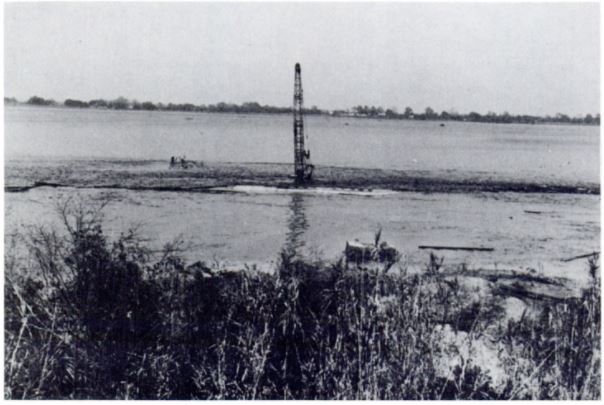
Photo from a 1981 government report on Texaco’s accidental “Jefferson Island Mine Inundation” of one year earlier.
“Texaco, who had ordered the oil probe, was aware of the salt mine’s presence and had planned accordingly; but somewhere a miscalculation had been made, which placed the drill site directly above one of the salt mine’s 80-foot-high, 50-foot-wide upper shafts,” noted a 2005 article.
According to a 1981 government report, “Jefferson Island Mine Inundation,“ evidence for identifying the exact cause was washed away, but Texaco and Wilson Drilling paid $32 million to Diamond Crystal Salt Company and another $12.8 million to a nearby botanical garden. Changed from freshwater to saltwater with a depth reaching 200 feet, Lake Peigneur became the deepest lake in Louisiana.
November 21, 1925 – Magnolia Petroleum incorporates –
Formerly an unincorporated joint-stock association with roots dating to an 1889 refinery in Corsicana, Texas, Magnolia Petroleum Company incorporated. The original association had sold many grades of refined petroleum products through more than 500 service stations in Texas, Oklahoma, and Arkansas.
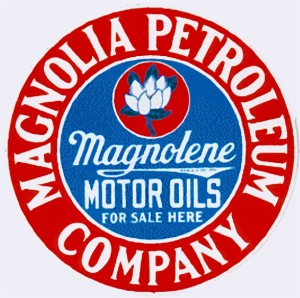
Magnolia Petroleum operated gas stations throughout the Southeast.
Within a month of the new company’s founding, John D. Rockefeller’s Standard Oil of New York (Socony) purchased most Magnolia Petroleum assets and operated it as a subsidiary. Magnolia merged with the Socony Mobile Oil Company in 1959 and adopted the red Pegasus logo, replacing the magnolia logo at gas stations (see Mobil’s High-Flying Trademark). Magnolia Petroleum assets were part of 1999 merger that created today’s ExxonMobil.

November 21, 1980 – Millions watch “Dallas” Episode Who shot J.R
The cliffhanger episode “Who shot J.R.?” on the prime-time soap opera “Dallas” was watched by 83 million people in the United States and 350 million worldwide, according to History.com. The CBS show, which debuted in 1978, revolved around two Texas oil families and featured Larry Hagman as J.R. Ewing, “the character fans loved to hate.” His portrayal of a “greedy, conniving, womanizing scoundrel” and the business dealings of Ewing Oil Company would stereotype the Texas petroleum industry for 14 seasons.
November 22, 1878 – Tidewater Pipe Company established
Byron Benson organized the Tidewater Pipe Company in Pennsylvania. In 1879 his company would build the first oil pipeline to cross the Alleghenies from Coryville to the Philadelphia Reading Railroad 109 miles away in Williamsport. This technological achievement was considered by many as the first true oil pipeline in America, if not the world.
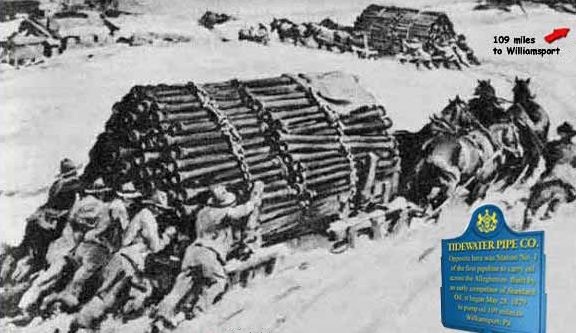
Despite protests from teamsters, a 109-mile oil pipeline revolutionized oil transportation. Photo courtesy explorepahistory.com.
The difficult work — much of it done in winter using sleds to move pipe sections — bypassed Standard Oil Company’s dominance in transporting petroleum. Tidewater made an arrangement with Reading Railroad to haul the oil in tank cars to Philadelphia and New York. In 1879, about 250 barrels of oil from the Bradford field was pumped across the mountains and into Williamsport.
More than 80 percent of America’s oil soon would come from Pennsylvania oilfields, according to Floyd Hartman Jr. in a 2009 article, “Birth of Coryville’s Tidewater Pipe Line.”

November 22, 1905 – Glenn Pool Field discovered in Indian Territory
Two years before Oklahoma statehood, the Glenn Pool (or Glenpool) oilfield was discovered in the Creek Indian Reservation south of Tulsa. The greatest oilfield in America at the time, it would help make Tulsa the “Oil Capital of the World.” Many independent oil producers, including Harry Sinclair and J. Paul Getty, got their start during the Glenn Pool boom.
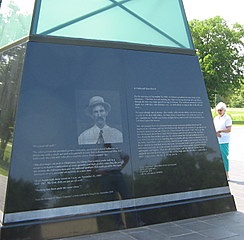
An oilfield pioneers monument was dedicated in April 2008 at Glenpool, Oklahoma. Photo by Bruce Wells.
With production exceeding 120,000 barrels of oil a day, Glenn Pool exceeded Tulsa County’s earlier Red Fork Gusher. The giant oilfield even exceeded production from Spindletop Hill in Texas four years earlier. The Ida Glenn No. 1 well, drilled to about 1,500 feet deep, led to more prolific wells in the 12-square-mile Glenn Pool.
By the time of statehood in 1907, Tulsa area oilfields made Oklahoma the biggest U.S. oil producing state. Advances in enhanced recovery technologies later added to the region’s productivity. Glenpool residents celebrate their “Black Gold Days,” and the 46th annual festival took place September 26-29, 2023, in Black Gold Park.
Learn more in Making Tulsa “Oil Capital of the World.”
November 22, 2003 – Smithsonian Museum opens Transportation Hall
A permanent exhibit about U.S. transportation history opened at the Smithsonian’s National Museum of American History in Washington, D.C. “Get your kicks on 40 feet of Route 66,” the Smithsonian exhibit noted on opening day of the $22 million renovation of the museum’s Hall of Transportation.
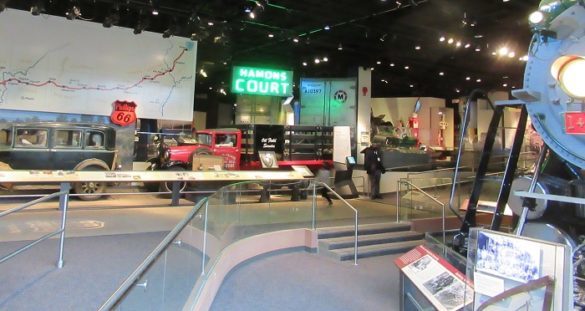
Opened in 2003 after a $22 million renovation, the Transportation Hall of the National Museum of American History exhibits 340 historic objects in 26,000 square feet. Photo by Bruce Wells.
The hall was designed to let visitors “travel back in time and experience transportation as it changed America.” Opening day exhibits included 340 objects and 19 historic settings in chronological order. At the same museum in 1967, the Smithsonian’s “Hall of Petroleum” devoted an entire wing to drilling rigs, pipelines, and pump jacks.
Learn more in America on the Move.
November 23, 1951 – Superman and the World’s Deepest Oil Well
Public fear of the risk of drilling wells too deep highlighted the theatrical release of Superman’s first feature length movie, “Superman and the Mole Men.” The 1951 plot unfolded in the fictional town of Silsbey, “Home of the World’s Deepest Oil Well,” after an experimental well’s drill bit had “broken into clear air” at a depth of 32,742 feet.
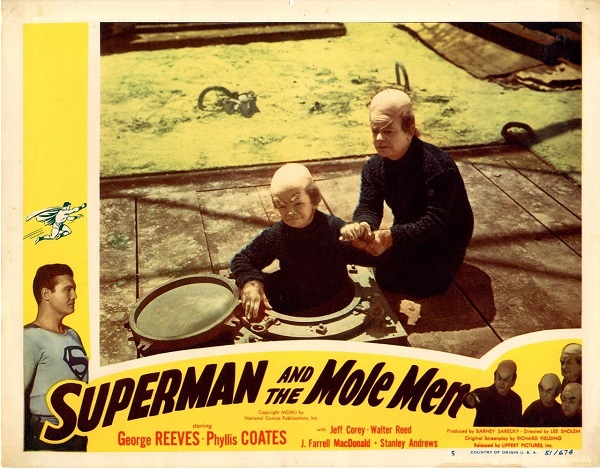
Mole men emerge from an experimental oil well drilled more than six miles deep.
“Good heavens, that’s practically to the center of the earth!” exclaimed Lois Lane (in fact, the deepest U.S. well in 1951 reached 20,521 feet). When mole-men emerged from the well, townspeople feared an invasion. In the end, Superman calmed an angry mob and the well ignited in flames, forever closing the connection between the two worlds.
Learn about a real six-mile-deep well in Anadarko Basin in Depth.

November 23, 1947 – World’s First LPG Ship
The first U.S. seagoing Liquefied Petroleum Gas (LPG) ship went into service as Warren Petroleum Corporation of Tulsa, Oklahoma, sent the Natalie O. Warren from the Houston Ship Channel to Newark, New Jersey. The vessel had an LPG capacity of 38,053 barrels in 68 vertical pressure tanks.

The first vessel had an LPG capacity of 38,053 barrels in 68 vertical pressure tanks.
The one-of-a-kind ship was the former Cape Diamond dry-cargo freighter, converted by the Bethlehem Steelyard in Beaumont, Texas. The experimental design would lead to new maritime construction standards for such vessels. Warren Petroleum was the largest producer and marketer of natural gasoline and propane in the world by the early 1950s, according to an exhibit at the Tulsa Historical Society and Museum. LPG tankers today carry 20 times the capacity of the early vessels.
November 25, 1875 – Continental Oil brings Kerosene to the West
Convinced that he could profit by purchasing bulk kerosene in cheaper eastern markets, Isaac Blake formed the Continental Oil and Transportation Company. He soon transported Ohio kerosene to Ogden, Utah, for distribution.
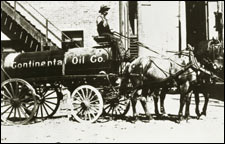
Conoco began in 1875 as Continental Oil, delivering kerosene to retail stores in Ogden, Utah.
Continental purchased two railroad tank cars — the first to be used west of the Mississippi River — and began shipping kerosene from a Cleveland refinery. The company grew, expanding into Colorado in 1876 and California in 1877. Standard Oil Company absorbed Continental Oil in 1885.
Following the 1911 breakup of Standard, Continental Oil reemerged as Conoco, becoming ConocoPhillips in 2002 (see ConocoPhillips Petroleum Museums).
_______________________
Recommended Reading: History Of Oil Well Drilling (2007); Be My Guest
(2007); Be My Guest (1957); Magnolia Oil News Magazine
(1957); Magnolia Oil News Magazine (January 1930); Oil and Gas Pipeline Fundamentals
(January 1930); Oil and Gas Pipeline Fundamentals (1993); Glenn Pool…and a little oil town of yesteryear
(1993); Glenn Pool…and a little oil town of yesteryear (1978); The American Highway: The History and Culture of Roads in the United States
(1978); The American Highway: The History and Culture of Roads in the United States (2000); CONOCO: The First One Hundred Years Building on the Past for the Future
(2000); CONOCO: The First One Hundred Years Building on the Past for the Future (1975). Your Amazon purchase benefits the American Oil & Gas Historical Society. As an Amazon Associate, AOGHS earns a commission from qualifying purchases.
(1975). Your Amazon purchase benefits the American Oil & Gas Historical Society. As an Amazon Associate, AOGHS earns a commission from qualifying purchases.
_______________________
he American Oil & Gas Historical Society (AOGHS) preserves U.S. petroleum history. Become an AOGHS annual supporting member and help maintain this energy education website and expand historical research. For more information, contact bawells@aoghs.org. Copyright © 2023 Bruce A. Wells. All rights reserved.
by Bruce Wells | Oct 2, 2023 | This Week in Petroleum History
October 2, 1919 – Future “Mr. Tulsa” incorporates Skelly Oil –
Skelly Oil Company incorporated in Tulsa, Oklahoma, with founder William Grove Skelly as president. He had been born in 1878 in Erie, Pennsylvania, where his father hauled oilfield equipment in a horse-drawn wagon.

Born near Pennsylvania’s early oilfields, independent oilman William Skelly’s company helped make Tulsa the “Oil Capital of the World.”
Skelly’s success in the El Dorado oilfield east of Wichita, Kansas, helped him launch Skelly Oil and other ventures, including Midland Refining Company, which he founded in 1917. As Tulsa promoted itself as “Oil Capital of the World,” Skelly became known as “Mr. Tulsa.”
Skelly served as president of Tulsa’s famous International Petroleum Exposition for 32 years until his death in 1957.

October 3, 1930 – East Texas Oilfield discovered on Widow’s Farm
With a crowd of more than 4,000 landowners, leaseholders, creditors, and spectators watching, the Daisy Bradford No. 3 remote wildcat well was successfully shot with nitroglycerin near Kilgore, Texas.

Spectators gathered on the widow Daisy Bradford’s farm near Kilgore, Texas, to watch the October 3, 1930, “shooting” of the discovery well of what proved to be the largest oilfield in the lower-48 states. Photo courtesy Jack Elder, The Glory Days.
“All of East Texas waited expectantly while Columbus ‘Dad’ Joiner inched his way toward oil,” explained historian Jack Elder in 1986. “Thousands crowded their way to the site of Daisy Bradford No. 3, hoping to be there when and if oil gushed from the well to wash away the misery of the Great Depression.” (more…)
by Bruce Wells | Sep 29, 2023 | Petroleum Pioneers
Giant Mid-Continent oilfield revealed in 1915 by emerging science of petroleum geology.
Community leaders in El Dorado, Kansas, were desperate for their town to live up to its name, especially after big natural gas discoveries at nearby Augusta and at Paola, south of Kansas City. It would be oil, not natural gas, that would do just that when a 1915 well revealed a giant oilfield east of Wichita. In 1918, the El Dorado field would produce almost 29 million barrels of oil.
One-hundred years after the historic discovery, the Butler County Times-Gazette told the prolific oilfield’s “black gold” story.
“In 1915, about 3,000 people called the rural agricultural community of El Dorado home,” the newspaper reported. “They had no idea events toward the end of that year would begin something that would forever change not just El Dorado, but the state and an entire industry.”
Petroleum Geologists
The science of petroleum geology played a key role in discovering the El Dorado oilfield — and many other Mid-Continent fields that followed. Drilled by Wichita Natural Gas, a subsidiary of Cities Service Company, beginning in late September 1915, the October 5 exploratory well revealed a 34-square-mile oilfield.

A marker erected in 1940 at the Stapleton No. 1 well commemorates the October 5, 1915, discovery of the El Dorado, Kansas, oilfield. Photo by Bruce Wells.
The Stapleton No. 1 well produced 95 barrels a day from 600 feet before being deepened to 2,500 feet to produce 110 barrels of oil a day from the Wilcox sands. Discoveries one year earlier in nearby Augusta had prompted El Dorado city fathers to seek a geological study of the area, according to Larry Skelton of the Kansas Geological Survey.

“Pioneers named El Dorado, Kansas, in 1857 for the beauty of the site and the promise of future riches but not until 58 years later was black rather than mythical yellow gold discovered when the Stapleton No. 1 oil well came in on October 5, 1915,” explained Lawrence Skelton in a 1997 USGS Journal article.
By 1914 interest was growing in Butler county and south central Kansas. “A few positive finds had been made, but nothing exciting,” Skelton noted in “Striking It Big in Kansas” for the American Association of Petroleum Geologists (AAPG).
“Henry Doherty, founder of Cities Service in 1910, was seeking new gas reserves and opted for scientific exploration in lieu of wildcatting,” he wrote in the 2002 AAPG Explorer article.
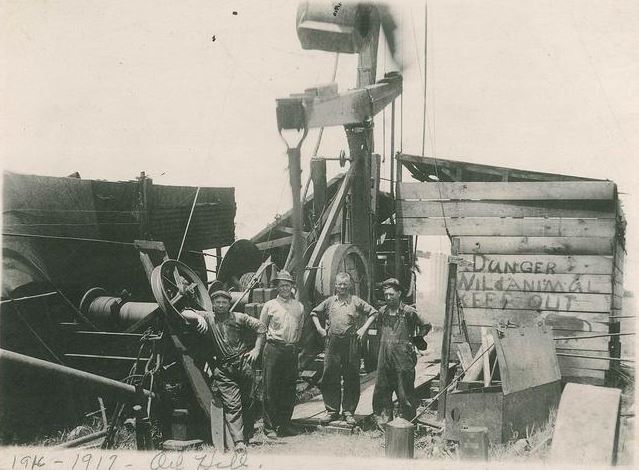
After the 1915 El Dorado oilfield discovery, few companies would drill a well without first seeking the advice of a geologist, Photo courtesy Kansas Oil Museum.
Doherty hired geologists Charles Gould and Everett Carpenter in Oklahoma, sending them to Augusta, in Butler County. Gould had organized the Oklahoma Geological Survey in 1908 and served as its first director until 1911. According to Skelton, the geologists mapped prominent anticlinal structures in Permian Age limestone.
Finding Oil at Anticlines
By late 1914, several Augusta exploratory wells found commercial volumes of natural gas. Several wells also found oil. These developments “chafed El Dorado city fathers.”
According to geologist Skelton, about 15 miles northeast of Augusta, El Dorado had unsuccessfully searched for hydrocarbons since the 1890s. City leaders decided to hire Erasmus Haworth, the state geologist and chairman of the University of Kansas geology department.
“He mapped a large anticline on the same formations used by Gould and Carpenter at Augusta and selected a site that proved to be a dry hole,” Skelton explained.

Undeterred, Cities Service subsidiary Wichita Natural Gas bought the town’s 790 leased acres for $800, verified Haworth’s work and began drilling in late September 1915. The Stapleton No. 1 well found oil within a week.
“Using scientific geological survey methodology for the first time, Cities Service had identified a promising anticline,” Skelton noted. “His field work outlined the El Dorado Anticline.”
Butler County’s geologic revelations encouraged Gulf Oil, Standard Oil, and other companies to acquire leases around Augusta and El Dorado. In addition to Henry Doherty, industry leaders like Archibald Derby, John Vickers and William Skelly established successful El Dorado oil-producing and refining companies.
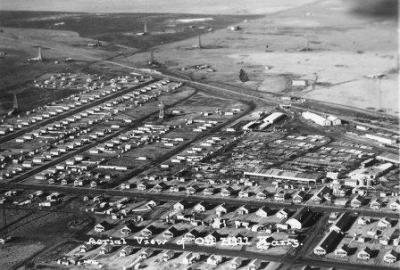
As Butler County wells multiplied, Oil Hill became the largest “company towns” in the world with some 8,500 residents. Photo courtesy Kansas Oil Museum.
“So the idea from that point forward, no oil company in the world would go and drill a well without seeking the advice of a geologist first,” proclaimed the executive director of the Kansas Oil Museum.
“Before 1915, geologists were seen in the same vein as witching and doodlebugs. They were just charlatans,” explained Warren Martin in a 2015 Butler County Times-Gazette article on the centennial of Stapleton No. 1 well.

“It fundamentally transformed it from that point going forward,” Martin added. “Geology was established as one of the great science industries.”
Also see Rocky Beginnings of Petroleum Geology.
Kansas Oil and Gas Boom
With the influx of thousands of workers, even Wichita accommodations were overwhelmed. Butler County’s population, about 23,000 in 1910, nearly doubled in 1920. To house its workers, Empire Gas & Fuel Company (formerly Wichita Natural Gas) built a 64-acre town northwest of El Dorado.
When the United States entered World War I, oil production escalated with the El Dorado field producing almost 29 million barrels of oil in 1918 — about nine percent of the nation’s oil.
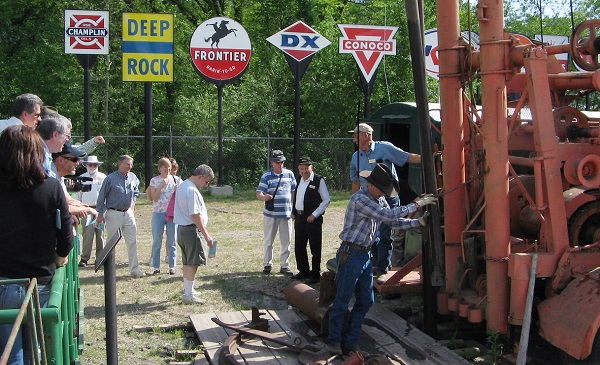
The Kansas Oil Museum includes drilling and production equipment. The museum annually hosts a “Rockfest celebration of geology and oil and gas culture.” Photo by Bruce Wells
Although Oil Hill and its more than 8,000 residents, swimming pool, tennis courts and small golf course would disappear by the late 1950s, at the time it was called the largest “company town” in the world.
The Stapleton No. 1 well, which produced oil until 1967, can be visited by tourists — as can El Dorado’s Kansas Oil Museum, which includes 20 acres of rig displays, equipment exhibits and models of the region’s refinery history. The museum hosts events in an Energy Education Center, offers a variety of K-12 programs, and annually celebrates a “Rockfest” for aspiring geologists.
The Kansas museum’s pumping unit exhibits, the largest one on the grounds, educates visitors about evolving production technologies. It includes a 1970s pumpjack donated by Hawkins Oil Company. Visitors explore a variety of buildings depicting a typical petroleum boom town like Oil Hill.

The state’s earliest oil production began in 1892 at Neodesha in eastern Kansas — the first Kansas oil well — later proclaimed the first commercial discovery west of the Mississippi River.
A natural gas well along the Oklahoma border at Caney, ignited in 1906 and took five weeks to bring under control (see Kansas Gas Well Fire). In far western Kansas, the Hugoton Natural Gas Museum preserves the history of a multistate natural gas geologic formation.
_______________________________________________
The American Oil & Gas Historical Society (AOGHS) preserves U.S. petroleum history. Become an AOGHS annual supporting member and help maintain this energy education website and expand historical research. For more information, contact bawells@aoghs.org. Copyright © 2023 Bruce A. Wells. All rights reserved.
Citation Information – Article Title: “Kansas Oil Boom.” Authors: B.A. Wells and K.L. Wells. Website Name: American Oil & Gas Historical Society. URL: https://aoghs.org/petroleum-pioneers/kansas-oil-boom. Last Updated: September 29, 2023. Original Published Date: October 4, 2015.

















